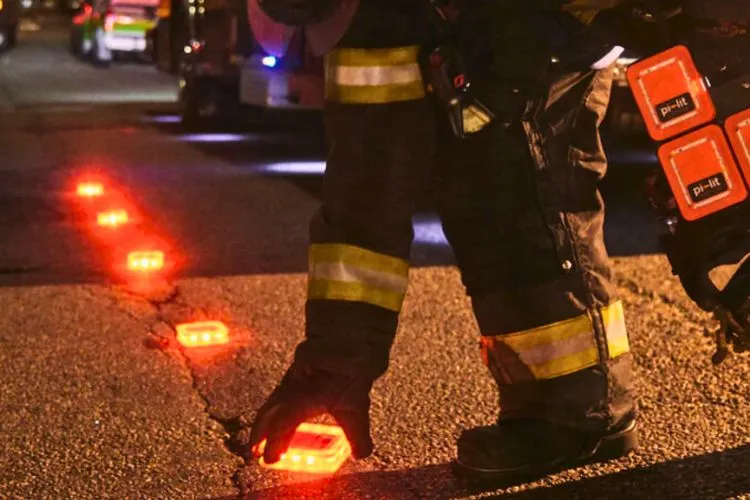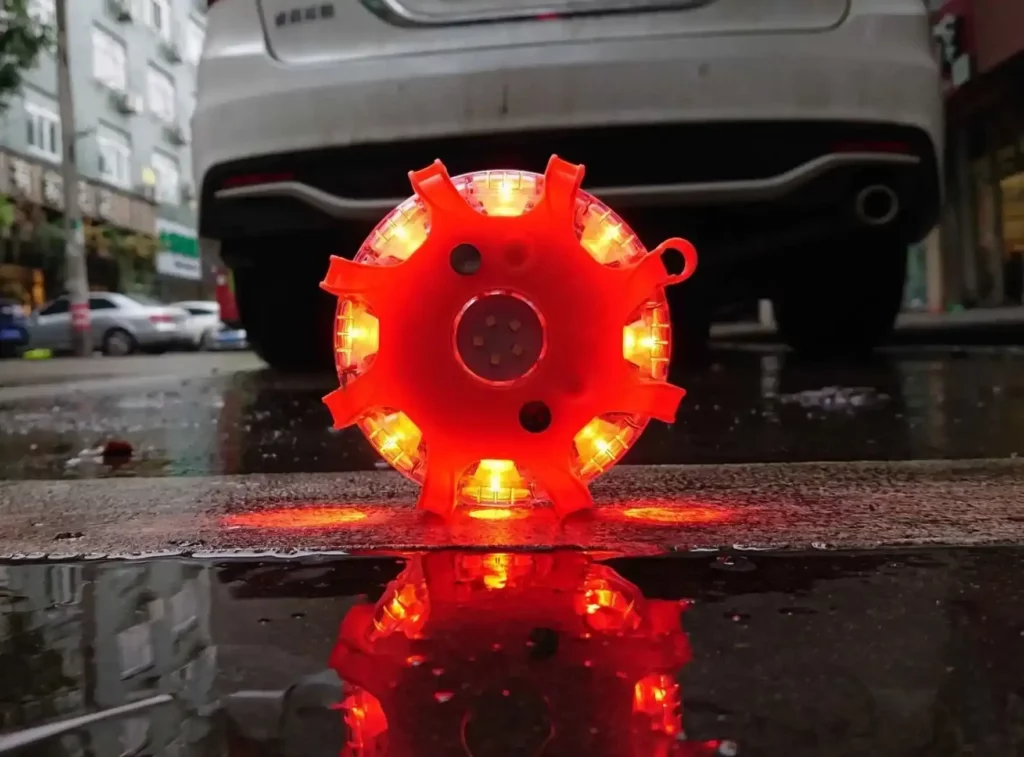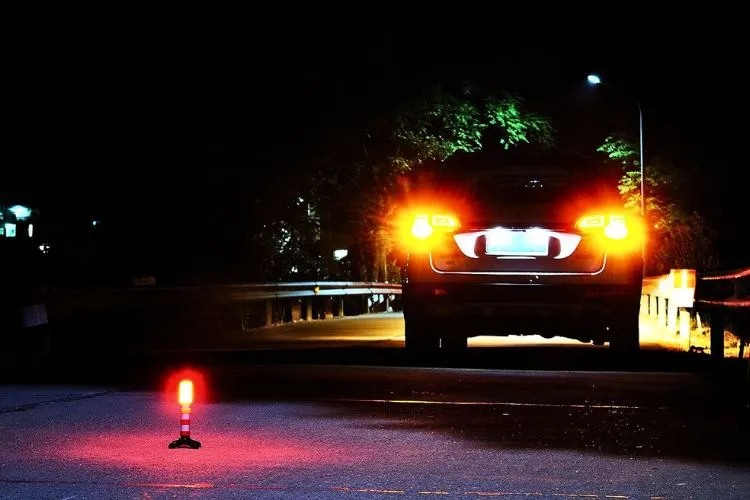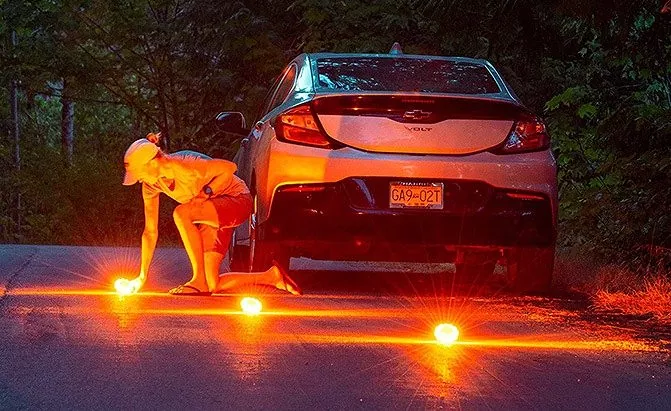Road flares have been a staple in emergency roadside safety kits for many years. They provide a clear signal for help and warn other drivers of potential dangers ahead.
But, are road flares toxic?
Honestly speaking, the topic of their toxicity has been a cause for concern among users and environmentalists alike.
In this article, we aim to explore the components of road flares, the risks they present, and whether there exist safer alternatives.

Are Road Flares Toxic?
Road flares consist of several ingredients that work together to produce their bright, burning light. One of the primary chemicals is strontium nitrate, which facilitates the red color in the flame.
Potassium perchlorate often accompanies it as an oxidizer, allowing the flare to burn in the absence of external oxygen.
These flares also contain binding agents that hold the formulation together, such as sawdust, which doubles as fuel to help sustain the burn. For flares that produce different colors, various chemicals are used. For instance, strontium compounds burn red, while magnesium burns white.
Risks Associated with Road Flares
The primary concern with road flares is the release of toxic fumes during combustion. When a flare burns, it emits gases like hydrogen chloride and sulfur oxides, which pose health risks. Inhaling these can lead to respiratory issues and irritation of the eyes, nose, and throat.

Moreover, the environmental impact of flare residue that lingers on the ground or enters water systems is troubling. This residue can be harmful to plants and wildlife, leading to longer-term ecological damage.
Users must also be careful when handling active flares, as they burn at high temperatures and can cause severe burns upon contact.
Disposal is another issue, as spent flares contain remnants of toxic compounds and need to be handled according to safety regulations to prevent environmental harm.
Legal and Safety Regulations
Safety guidelines for the use and disposal of road flares differ from one region to another. In the United States, there are specific state regulations that users must adhere to. These regulations often dictate where and when flares can be used and the accepted methods for disposing of them.
Alternatives to Traditional Road Flares
In recent years, the push for safer, non-toxic alternatives to traditional road flares has gained momentum.
Electronic or LED flares are a popular choice, offering the benefit of being reusable and eliminating the production of harmful fumes. These flares can have various light settings and are often waterproof, making them versatile.

Chemical light sticks are another alternative. They do not produce flames or toxic fumes, although they present a one-time-use option that may not be as visible as traditional flares.
Nonetheless, the search for eco-friendly innovations in road safety signaling continues, with researchers working on developing better solutions.
Case Studies and Recent Research
Several case studies have highlighted the adverse effects of road flare toxicity on human health and the environment.
For instance, research indicates that the chemicals in flares can persist in the environment, leading to soil and water contamination. Efforts are ongoing to find a balance between effective emergency signaling and environmental conservation.
Pro Tips Box
When handling road flares, always ensure that they are stored in a dry place and used according to the manufacturer’s instructions.
It’s essential to weigh the pros and cons of traditional versus alternative flares, especially in emergency situations where visibility and reliability are key.
Handling and Safety Precautions
When using road flares, prioritizing safety is paramount for both the user and the environment. To ignite and deploy flares safely, ensure you are standing upwind to avoid inhaling smoke, and hold the flare away from your body and face.

Use the flare’s striker to ignite it, pointing the flare down and to the side. For extinguishing, let the flare burn out naturally in a safe area away from flammable materials, as attempting to smother the flame might not be effective.
Store flares in a cool, dry place, away from direct sunlight and heat sources to prevent accidental ignition. Keeping them in their original container or a designated safety box minimizes exposure to moisture, which could compromise their usability.
Adhering to these guidelines ensures that road flares are ready for use when necessary while maintaining safety and effectiveness.
Advances in Road Safety Technology
Advances in road safety technology are transforming emergency signaling through the development of emerging technologies, such as high-intensity LED lights, which offer visibility comparable to traditional flares without the associated risks.

Research focuses on eco-friendly materials, aiming to replace hazardous chemicals in flares with sustainable alternatives.
Innovations include non-toxic signaling devices, harnessing advancements in biodegradable compounds and energy-efficient lighting, to improve safety without compromising environmental integrity. These strides represent a significant shift towards safer, greener roadside emergency solutions.
Frequently Asked Questions (FAQs)
How long do traditional road flares burn?
Most flares will burn for approximately 15 to 60 minutes, depending on their design and weather conditions.
Are road flares illegal to use in certain areas or states?
Yes, some areas have restrictions on the use of road flares due to the fire hazard they pose. Always check local regulations before use.
Can used road flares be recycled?
Typically, road flares cannot be recycled due to their chemical residue. They should be disposed of according to local hazardous waste guidelines.
What are the immediate first aid steps if exposed to flare smoke?
Move to a fresh air location immediately and rinse any affected skin or eyes with cool water. Seek medical attention if symptoms persist.
How do weather conditions affect the use of road flares?
Wet or windy conditions can reduce the effectiveness of road flares. LED or electronic flares may be more suitable in such cases.
Conclusion:
The evidence suggests that traditional road flares can be toxic, and their use comes with health and environmental risks. While they have been crucial in roadside safety, it is vital for users to exercise caution and consider alternative signaling devices that are less harmful.
This article serves to address safety concerns regarding road flares. It guides users in making informed decisions, balancing the need for effective emergency signals with the responsibility of protecting health and the environment.


